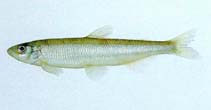http://www.fishbase.org/Summary/speciesSummary.php?genusname=Hypomesus&speciesname=olidus ---> http://192.134.151.83/Summary/speciesSummary.php?genusname=Hypomesus&speciesname=olidus
http://192.134.151.83/Summary/speciesSummary.php?genusname=Hypomesus&speciesname=olidus ---> https://fishbase.mnhn.fr/Summary/speciesSummary.php?genusname=Hypomesus&speciesname=olidus
https://fishbase.mnhn.fr/Summary/speciesSummary.php?genusname=Hypomesus&speciesname=olidus ---> https://fishbase.mnhn.fr/summary/Hypomesus-olidus.html
Hypomesus olidus, Pond smelt : fisheries

You can
sponsor
this page
Common name (e.g. trout)
Genus + Species (e.g. Gadus morhua)
-

-
About this page
-
Languages
-
User feedbacks
-
Citation
-
Uploads
-
Related species
-


 Pond smelt
Upload your
photos
and
videos
Pond smelt
Upload your
photos
and
videos
Pictures
|
Google image
 Hypomesus olidus
Hypomesus olidus
Picture by
Kim, I.-S.
Teleostei (teleosts) >
Osmeriformes
(Freshwater smelts) >
Osmeridae
(Smelts)
Etymology:
Hypomesus:
Greek, hypo = under + Greek,mesos = a half (Ref.
45335
)
.
More on author:
Pallas
.
Environment: milieu / climate zone / depth range / distribution range
Ecology
Marine; freshwater; brackish; pelagic-neritic; anadromous (Ref.
33312
); depth range 10 - ? m (Ref.
5723
). Boreal; 71°N - 55°N
Arctic, Northwest to Northeast Pacific: drainages from Rae River (Coronation Gulf) and Great Bear Lake in Northwest Territories, Canada to Copper River in Alaska (Ref.
33312
). Also rivers, estuaries and coastal waters of European and Siberian shores of Artic Ocean, from Kara drainage to Chukotka in eastern Siberia and to Korea and Hokkaido in Japan (Ref.
59043
).
Length at first maturity / Size / Weight / Age
Maturity: L
m
10.0
range ? - ? cm
Max length : 20.0 cm TL male/unsexed; (Ref.
86798
); common length : 11.3 cm TL male/unsexed; (Ref.
12193
); max. published weight: 50.00 g (Ref.
56527
); max. reported age: 10 years (Ref.
72499
)
Dorsal
spines
(total): 0;
Dorsal
soft rays
(total): 8-11;
Anal
spines
: 0;
Anal
soft rays
: 13 - 17;
Vertebrae
: 52 - 56. Vomer without posterior process; periphery of glossohyal bone with single row of conical teeth, another row of smaller teeth in center; pyloric caeca 2 (1-5); base of adipose fin more than 20% of head length; adipose eyelid absent.
Inhabits brackish water of estuaries, lagoons, coastal waters of open sea, freshwater of lowland and piedmont rivers and lakes (Ref.
59043
). Found in the middle and surface waters of ponds, lakes, and streams over a variety of bottom types (Ref.
5723
,
86798
). The species is basically anadromous, ascending rivers to spawn in spring (Ref.
33312
). The anadromous populations are pelagic at the sea, commonly at 4-5 m depth and spawn in rivers. Landlocked populations may spawn in lakes or undertake migration to their tributaries. Spawns along shallow river shores and in backwaters with little or no current, often in lakes, on sand or gravel bottom (Ref.
59043
). Within a specific lake or pond, adults are generally found in inshore spawning areas in spring and early summer, later moving offshore (Ref.
27547
). Feeds on zooplankton, insects and algae (Ref.
28680
,
28681
). Only a few survive beyond age 3 (Ref.
27547
).
Saruwatari, T., J.A. López and T.W. Pietsch
, 1997. A revision of the ormerid genus
Hypomesus
Gill (Teleostei: Salmoniformes), with a description of a new species from the southern Kuril Islands. Species Diversity 2:59-82. (Ref.
33312
)
IUCN Red List Status (Ref.
130435
)
Least Concern (LC)
; Date assessed:
16 February 2012
CITES
Not Evaluated
Not Evaluated
Threat to humans
Harmless
Human uses
Fisheries: commercial
FAO - Aquaculture:
production
; Fisheries:
landings
; Publication:
search
|
FishSource
|
More information
Countries
FAO areas
Ecosystems
Occurrences
Introductions
Stocks
Ecology
Diet
Food items
Food consumption
Ration
Common names
Synonyms
Metabolism
Predators
Ecotoxicology
Reproduction
Maturity
Spawning
Spawning aggregation
Fecundity
Eggs
Egg development
Age/Size
Growth
Length-weight
Length-length
Length-frequencies
Morphometrics
Morphology
Larvae
Larval dynamics
Recruitment
Abundance
BRUVS
References
Aquaculture
Aquaculture profile
Strains
Genetics
Electrophoreses
Heritability
Diseases
Processing
Nutrients
Mass conversion
Collaborators
Pictures
Stamps, Coins Misc.
Sounds
Ciguatera
Speed
Swim. type
Gill area
Otoliths
Brains
Vision
Tools
E-book
|
Field guide
|
Identification keys
|
Length-frequency wizard
|
Life-history tool
|
Point map
|
Classification Tree
|
Catch-MSY
|
Special reports
Check for Aquarium maintenance
|
Check for Species Fact Sheets
|
Check for Aquaculture Fact Sheets
Download XML
Summary page
|
Point data
|
Common names
|
Photos
Internet sources
AFORO (otoliths) |
Alien/Invasive Species database
|
Aquatic Commons
|
BHL
|
Cloffa
|
BOLDSystems
|
Websites from users
|
Check FishWatcher
|
CISTI
|
Catalog of Fishes
:
genus
,
species
|
DiscoverLife
|
ECOTOX
| FAO - Aquaculture:
production
; Fisheries:
landings
; Publication:
search
|
Faunafri
| Fishipedia |
Fishtrace
| GenBank:
genome
,
nucleotide
|
GloBI
|
Google Books
|
Google Scholar
|
Google
| IGFA World Record |
MitoFish
|
Otolith Atlas of Taiwan Fishes
|
PubMed
| Reef Life Survey | Socotra Atlas |
Tree of Life
| Wikipedia:
Go
,
Search
| World Records Freshwater Fishing |
Zoological Record
Estimates based on models
Phylogenetic diversity index (Ref.
82804
): PD
50
= 0.5313 [Uniqueness, from 0.5 = low to 2.0 = high].
Bayesian length-weight: a=0.00398 (0.00249 - 0.00637), b=3.20 (3.06 - 3.34), in cm total length, based on LWR estimates for this species & (Sub)family-body (Ref.
93245
).
Trophic level (Ref.
69278
): 3.2 ±0.3 se; based on diet studies.
Resilience (Ref.
120179
): Medium, minimum population doubling time 1.4 - 4.4 years (tm=2; tmax=5).
Fishing Vulnerability (Ref.
59153
): Low vulnerability (10 of 100).
Price category (Ref.
80766
):
Low
.
Back to Search
Random Species
Back to Top
Accessed through:
Not available
FishBase mirror site :
localhost
Page last modified by :
mrius-barile
- 20 July 2016
Fatal error
: Uncaught ArgumentCountError: Too few arguments to function checkEcotox(), 1 passed in /var/www/html/summary/speciessummary.php on line 2304 and exactly 3 expected in /var/www/html/includes/speciessummary.lib.php:2579 Stack trace: #0 /var/www/html/summary/speciessummary.php(2304): checkEcotox() #1 {main} thrown in
/var/www/html/includes/speciessummary.lib.php
on line
2579
|